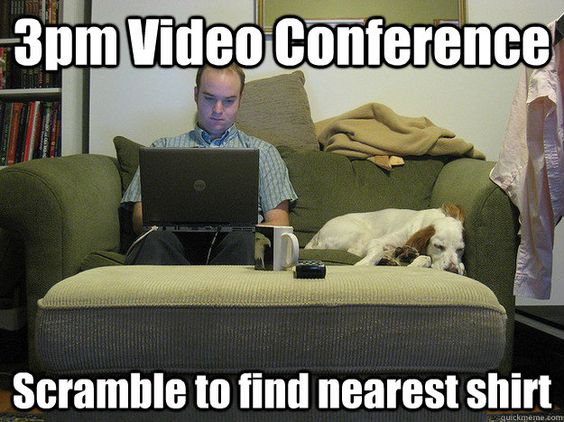5 Tips for communicating effectively on a Remote Team
Effective communication requires emotional intelligence and interpersonal skills. Sharpen your visually verbal technique with these practical tips.

The other day, our engineer mentioned, "I think texting vs. speaking to someone can sometimes cause confusion. You lose intonation."
Effective communication goes beyond using your words. It encompasses several other aspects such as non-verbal cues, emotional intelligence, and active listening. What does this mean in the remote world? After chatting to a handful of remote workers, we've narrowed it down below for you. Whether you're on the hunt for a remote job or already working on a distributed team, here are some practical tips to hone and finesse.
1. Keep your writing clear and concise
Goncalo Silva, CTO of Doist shared that quality writing is one of the first things they look for in a remote candidate. Communicating with tight copy seems simple in theory, but we all know simplicity is hard to achieve. You'd be surprised by how easy it is to add filler words. Combat this by zoning in on the intention behind your message and getting your point across in as little words as possible. Here's how:
Eliminate redundant words or phrases.
Example:
🙅 So, I was thinking that maybe, we could try meeting at twelve noon instead of 5:00pm for our weekly meetings. I plan on working from home in the afternoon and I was thinking that might be easier. What do you think?
vs.
🙆 I'd like to begin working from home in the afternoon from now on. Are you cool with changing our weekly meeting time from 5pm to 12pm?
Be assertive and direct. Refrain from using passive voice.
Passive: The website was designed by Joan.
Active: Joan designed the website.
Bonus tips:
- Edit, edit, edit.
- Give your message some breathing room and revisit it with fresh eyes after around 20-30 minutes.
- Triple check everything you write.
2. Be mindful of your virtual body language
Psychology Today states, "55 percent of communication is body language, 38 percent is the tone of voice, and 7 percent is the actual words spoken." So, how can we adapt to an environment where non-verbal communication isn't as prominent?

Video conferencing: posture is everything
When speaking, look into the camera and sit up straight.
"Posture not only shapes the way we feel, it also shapes the way we think about ourselves--from our self-descriptions to the certain and comfort with which we hold them. And those self-concepts can either facilitate or hinder our ability to connect with others, to perform our jobs, and, more simply, to be present."
-Carol Kinsey Goman, "The Nonverbal Advantage: Body Language at Work"
-Carol Kinsey Goman, "The Nonverbal Advantage: Body Language at Work"
Writing: Enunciate your tone with formatting
Remote teams mainly deal with asynchronous communication. That's a lot of words and information simultaneously ping-ponging back and forth. And, although concise writing is encouraged, sometimes, direct communication can be taken as abrupt or rude. Formatting your copy and including emojis & images can help convey tone.
Formatting: general rule of thumb
Italics: use for light emphasis, and to highlight quotes, names of publications, conversations or dialogues, stories, etc.
It feels strategic and creative at the same time.
Bold: use for strong emphasis
It feels strategic and creative at the same time.
It feels strategic and creative at the same time.
Bold: use for strong emphasis
It feels strategic and creative at the same time.
CAPS: used to denote shouting or aggressiveness
It FEELS strategic and creative at the same time.
It FEELS strategic and creative at the same time.
Friendly tip: A conversation in-person might be a better choice :)
Organize your text into clean paragraphs
Think of how you want your reader to digest your information.
Top your conversation up with Emojis, GIFs, and memes

But don't let these features take over, because that can detract from the conversation too.
Consider how you want your audience to understand your inflections
Example:
Umm... Let me think about that.
vs.
Hmm 🤔 Let me think about that.
In the first example, it's hard to read what the person thinks. Are they busy or pissed off? The emoji and direct phrase in the second example gives a much clearer impression.
3. Consider the context
Whether you're delivering the message or receiving it, considering the context of your co-worker could help prevent misunderstandings. A few examples of context are: knowing your co-worker's location, cultural norms, and native language.
A level up would be considering whether your colleague is having a bad day, going through a rough patch, or just feeling off.
Bonus tip: adding a quick 'check-in / check-out' update before and after a weekly meeting could encourage people to share in a manner that's high-level and informative.
4. Designate tools for specific communication
Too many tools=too many places for people to comment and relay information=missed messages or people feeling overwhelmed/bombarded. Basically, conversations are being scattered across multiple channels - across the globe, at that - and then missed.

In general, this is what we've observed as effective ways to structure your communication flow:
- Keep your questions and side conversation to chat apps, like Slack
- Send formal requests or action-related items via email
- Provide status updates through a project management tool
Find a system that works best for your team and let everyone know with change communications in mind.
5. Think critically
It's easy to blame miscommunication on either the person who's sending the message or the one who's receiving it. Don't be that person; nobody's fond of the guy who plays the blame game. Instead, be mindful of how the message could be perceived and interpreted.
- Consider your words
- Adapt your communication to who you're speaking with
- Think of when your message is being delivered (ex. Sending a status update at 9am vs 5pm)
- Ask for feedback
- Clarify and summarize (ex. "What I'm interpreting is...", "From what you stated, I'm gathering...")

Lastly, consider the medium for the message. For example, delivering feedback may sometimes seem more efficient over chat, but pairing it with a conversation over the phone or video could help avoid any miscommunication.